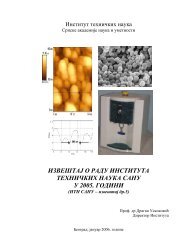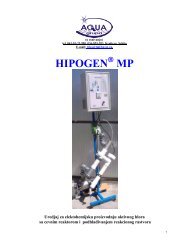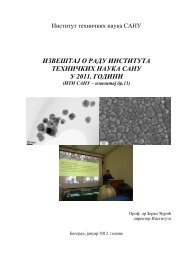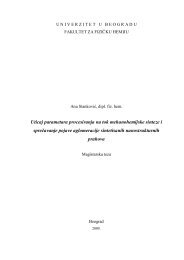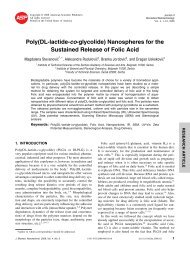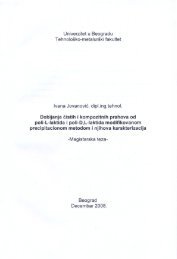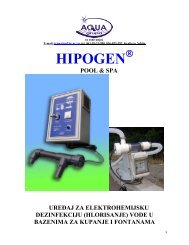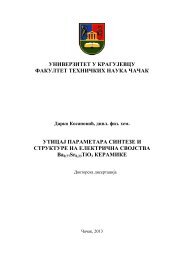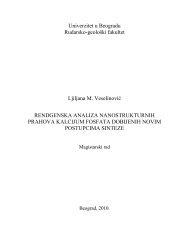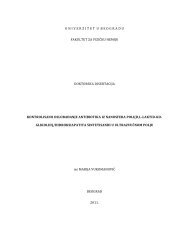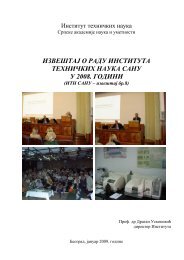Program and the Book of Abstracts (PDF) - Mrs-serbia.org.rs
Program and the Book of Abstracts (PDF) - Mrs-serbia.org.rs
Program and the Book of Abstracts (PDF) - Mrs-serbia.org.rs
You also want an ePaper? Increase the reach of your titles
YUMPU automatically turns print PDFs into web optimized ePapers that Google loves.
Tenth Young Researche<strong>rs</strong> Conference – Materials Science <strong>and</strong> Engineering<br />
December 21-23, 2011, Hall 2, SASA, Knez Mihailova 35 & 36, Belgrade, Serbia<br />
I/5<br />
Multilayered core-shell nanoparticle model<br />
for biomaterials delivering<br />
Stevan Armaković 1 , Ana J. Šetrajčić-Tomić 2 , Igor J. Šetrajčić 1<br />
1 Unive<strong>rs</strong>ity <strong>of</strong> Novi Sad, Faculty <strong>of</strong> Sciences, Department <strong>of</strong> Physics, Vojvodina – Serbia<br />
2 Unive<strong>rs</strong>ity <strong>of</strong> Novi Sad, Medical Faculty, Department <strong>of</strong> Pharmacy, Vojvodina – Serbia<br />
We analyzed application <strong>of</strong> nanomaterials in biomedicine, that is to say we will present <strong>the</strong><br />
recent accomplishments in basic <strong>and</strong> clinical nanomedicine. Achieving full potential <strong>of</strong><br />
nanomedicine may be yea<strong>rs</strong> or even decades away, however, potential advances in drug delivery,<br />
diagnosis, <strong>and</strong> development <strong>of</strong> nanotechnology-related drugs start to change <strong>the</strong> medicine. Implants,<br />
especially in dentistry, due to new biomaterials <strong>and</strong> thin coatings with specific tasks, are now<br />
widely used. Based on our research in ultra-thin crystalline structures performed so far, we will<br />
consider <strong>the</strong> core-shell multilayer materials that can act as carrie<strong>rs</strong> for medicines <strong>and</strong> tagged<br />
substances.<br />
I/6<br />
Controlled release <strong>of</strong> aspirin from surfactant-modified natural zeolite<br />
Sanja Jevtić 1 , Svetlana Grujić 1 , Gregor Mali 2 , Nevenka Rajić 1<br />
1 Unive<strong>rs</strong>ity <strong>of</strong> Belgrade, Faculty <strong>of</strong> Technology <strong>and</strong> Metallurgy, Belgrade, Serbia,<br />
2 National Institute <strong>of</strong> Chemistry, Ljubljana, Slovenia<br />
Natural zeolite (NZ) from south region <strong>of</strong> Serbia has been investigated as a carrier for controlled<br />
release <strong>of</strong> aspirin. In order to modify <strong>the</strong> adsorption ability <strong>of</strong> zeolite, NZ was pretreated with<br />
cationic surfactant - benzalkonium chloride (BC). Aspirin release from <strong>the</strong> composite NZ-BC<br />
displays two stages. The fi<strong>rs</strong>t stage occu<strong>rs</strong> within fi<strong>rs</strong>t 15 minutes whereas <strong>the</strong> second one proceeds<br />
gradually over 6 hou<strong>rs</strong>. Release pr<strong>of</strong>ile indicates that <strong>the</strong> delivery is controlled by a diffusion<br />
process in <strong>the</strong> fi<strong>rs</strong>t stage <strong>and</strong> by <strong>the</strong> electrostatic interaction between <strong>the</strong> drug <strong>and</strong> surfactant in <strong>the</strong><br />
second stage.<br />
3





